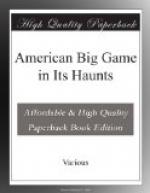The Red Salmon River of Seal Harbor, to which we were headed, could not fail us, for bear could scoop out the salmon in armfuls below the lower falls, so Vacille said, and he was honest, and now as keen as anything while traveling his own hunting grounds.
For a whole week a northeast storm blew directly toward the bay, and kept us in camp. It was fishing weather, however, and my fly-rod, with a Parmachenee belle, kept us well supplied with steelheads and speckled trout, which were plentiful in the clear waters of a wandering trout brook running through a meadow below the camp.
A calm evening came finally, and we paddled down the last lake, some three miles, to the famous pool.
There were the salmon swarming below the fall, and many constantly in the air on their upward journey, but the eagles perched high on the dark spruces, closing in the swirling water, were all they had to fear. There were no bears and no fresh bear signs. It was an ideal spot, this salmon pool, but a feast for the eyes only, as the red salmon will not rise to a fly. Even Tchort looked disconsolate on our track back to Ozinka.
About July 10 there is usually a run of dog salmon, and not much later another of humpbacks. The dog salmon grow to be about twice as large as the red salmon, and often weigh 12 pounds. They are much more sluggish than the red fish, and as they prefer the small shallow streams, become an easy prey for the bear. The humpback fish are fatter and better eating even than the red salmon, but are somewhat smaller.
The red fish never ascend a stream which has not a lake on its upper waters for spawning. The dog and humpback, on the contrary, are not so particular, and are found almost everywhere. In September there is a run of silver salmon, which, like the red salmon, will only swim a stream with a lake at its head. They run up to 40 pounds, and the bears grow fat on them before turning into winter quarters. The skeletons of this big fish, cleaned by bear, are found along every small stream running from the lakes.
The large canneries, like the one at Karluk, on Karluk River, near the western end of Kadiak, put up only the red salmon. They are not nearly as good eating as the humpback or silver salmon, but are red, and this color distinction the market demands. The catches at Karluk run up into the tens of thousands, and one thinks of this with many misgivings, remembering the fate of the sea otter and bear. Good hatcheries are constantly busy, keeping up the supply, but it appears that though one in every ten thousand of these fish is marked before being set free, so far as known no marked fish have ever been captured.
On our return to Kadiak Island, we found the streams still free of salmon, and the vegetation had become so rank as to interfere a good deal with traveling and sighting game. The whole party looked serious, and the strain was beginning to tell, no game having been seen for seven long weeks. This, with the swarms of gnats and mosquitoes, made time pass heavily.




